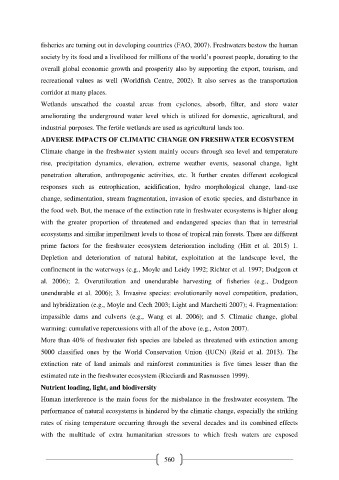Page 570 - e-Book
P. 570
fisheries are turning out in developing countries (FAO, 2007). Freshwaters bestow the human
society by its food and a livelihood for millions of the world’s poorest people, donating to the
overall global economic growth and prosperity also by supporting the export, tourism, and
recreational values as well (Worldfish Centre, 2002). It also serves as the transportation
corridor at many places.
Wetlands unscathed the coastal areas from cyclones, absorb, filter, and store water
ameliorating the underground water level which is utilized for domestic, agricultural, and
industrial purposes. The fertile wetlands are used as agricultural lands too.
ADVERSE IMPACTS OF CLIMATIC CHANGE ON FRESHWATER ECOSYSTEM
Climate change in the freshwater system mainly occurs through sea level and temperature
rise, precipitation dynamics, elevation, extreme weather events, seasonal change, light
penetration alteration, anthropogenic activities, etc. It further creates different ecological
responses such as eutrophication, acidification, hydro morphological change, land-use
change, sedimentation, stream fragmentation, invasion of exotic species, and disturbance in
the food web. But, the menace of the extinction rate in freshwater ecosystems is higher along
with the greater proportion of threatened and endangered species than that in terrestrial
ecosystems and similar imperilment levels to those of tropical rain forests. There are different
prime factors for the freshwater ecosystem deterioration including (Hitt et al. 2015) 1.
Depletion and deterioration of natural habitat, exploitation at the landscape level, the
confinement in the waterways (e.g., Moyle and Leidy 1992; Richter et al. 1997; Dudgeon et
al. 2006); 2. Overutilization and unendurable harvesting of fisheries (e.g., Dudgeon
unendurable et al. 2006); 3. Invasive species: evolutionarily novel competition, predation,
and hybridization (e.g., Moyle and Cech 2003; Light and Marchetti 2007); 4. Fragmentation:
impassible dams and culverts (e.g., Wang et al. 2006); and 5. Climatic change, global
warming: cumulative repercussions with all of the above (e.g., Aston 2007).
More than 40% of freshwater fish species are labeled as threatened with extinction among
5000 classified ones by the World Conservation Union (IUCN) (Reid et al. 2013). The
extinction rate of land animals and rainforest communities is five times lesser than the
estimated rate in the freshwater ecosystem (Ricciardi and Rasmussen 1999).
Nutrient loading, light, and biodiversity
Human interference is the main focus for the misbalance in the freshwater ecosystem. The
performance of natural ecosystems is hindered by the climatic change, especially the striking
rates of rising temperature occurring through the several decades and its combined effects
with the multitude of extra humanitarian stressors to which fresh waters are exposed
560

